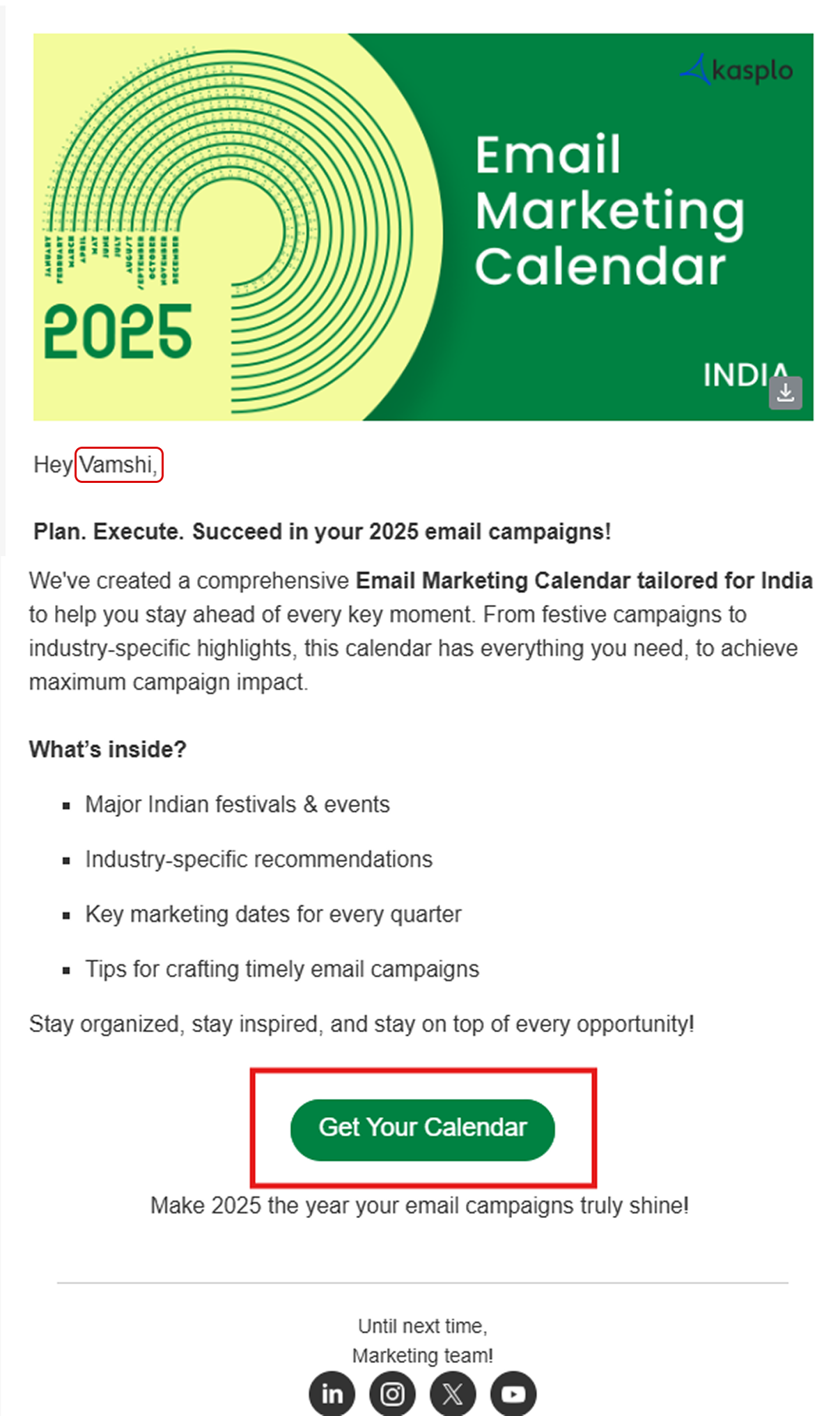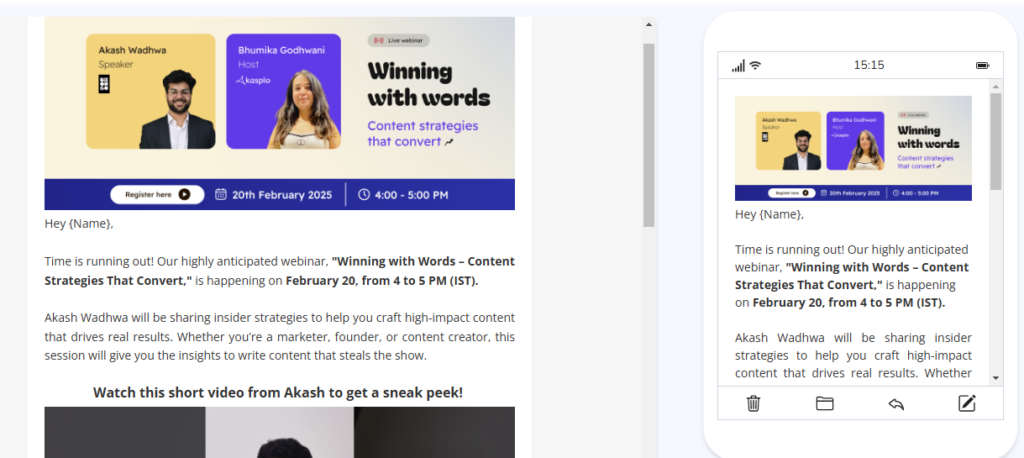Newsletters are one of the most effective ways to connect with your audience, but many businesses still miss the mark when crafting them. Whether it’s failing to personalize content or neglecting mobile optimization, common mistakes are easy to make. These missteps can affect your open rates, click-through rates, and overall engagement. In this post, we’ll walk you through nine common newsletter mistakes most marketers overlook—and how you can avoid them. Let’s dive in and make sure your next newsletter delivers the impact you’re aiming for.
1. Not personalizing content for different segments
It’s tempting to send the same newsletter to your entire list. But this is a huge missed opportunity. Your audience isn’t homogenous, and sending a one-size-fits-all message doesn’t do justice to the diverse interests of your subscribers. In fact, personalized email content can increase transaction rates by 6x.
Imagine receiving a newsletter that talks about a product you’re not interested in or a promotion that doesn’t apply to you. It’s frustrating, right? Personalization goes beyond addressing your subscribers by name. Segment your list based on their behavior, preferences, location, or previous interactions with your brand. For example, if someone recently purchased from you, send them a follow-up email with recommendations tailored to their interests or even a special loyalty offer.
A powerful tool like Kasplo can help you create dynamic content for different subscriber groups, ensuring that each recipient gets information that’s valuable and relevant to them. Personalization at scale can elevate your newsletter from generic to engaging—and that’s exactly what your audience craves.

2. Overlooking mobile optimization
Let’s face it: more than half of all emails are opened on mobile devices. Yet, many businesses still send newsletters that are not optimized for mobile viewing. You risk frustrating your subscribers if your emails don’t display well on smartphones, and you may lose them entirely.
Using a responsive design template is key. These templates automatically adjust based on screen size, ensuring that your newsletter looks good on any device. Here’s the catch: don’t just use mobile templates—test your emails on multiple devices before sending them out. You’ll want to ensure that the text is readable, images display correctly, and CTAs are easily clickable. The last thing you want is for your carefully crafted content to get lost in a mess of broken formatting on a smaller screen.
By making mobile optimization a priority, you increase your chances of creating a smooth, enjoyable reading experience, leading to higher engagement and better results.

3. Excessive focus on yourself
A big mistake many marketers make is using their newsletter as a soapbox to talk about themselves—their achievements, their awards, their promotions. While it’s fine to share some of your brand’s success stories, overdoing it will bore your subscribers.
Remember, your audience doesn’t subscribe to hear about your company’s latest awards; they want content that helps them solve a problem, learn something new, or stay informed. Rather than focusing entirely on yourself, make your subscribers the heroes of the story. Focus on providing valuable, insightful content that answers their needs. Whether it’s a helpful blog post, an exclusive interview, or a time-sensitive promotion that solves a pain point, the more value you offer, the more your subscribers will appreciate it.
Use storytelling that resonates with your audience. People connect with experiences, not just brands. So, give them the tools, insights, and inspiration to thrive, and they’ll keep coming back for more.
4. Neglecting to add CTAs
A newsletter without a call-to-action (CTA) is like a road trip with no destination. Every email you send should encourage readers to take action. Whether it’s visiting your website, reading a blog post, or making a purchase, a clear CTA helps guide your subscribers on the next step of their journey.
It’s essential to focus on one primary CTA per newsletter. Adding too many can confuse your readers, causing them to abandon the email altogether. For example, if you’re promoting a product, direct them to a product page. If you’ve written a blog post, lead them there. Keep your CTA simple and direct, ensuring your subscribers know exactly what to do next.
Also, make sure your CTA buttons stand out by using contrasting colors and strategic placement. They should be easy to spot and clickable. This small change can make a huge difference in boosting engagement.
5. Writing like a robot
Do you sound like a human or a robot when you write your newsletters? Too many businesses fall into the trap of using overly corporate language, which ends up feeling impersonal and distant. While you want to sound professional, you should also aim to sound approachable, friendly, and authentic.
Think of your subscribers like your guests at a party. They want to feel welcomed, not lectured. Writing in a conversational tone will make them feel like they’re having a chat with a real person—because, well, they are! Avoid jargon, and keep it simple. Use humor when appropriate, and inject personality into your content.
Human language connects better, so leave the formalities at the door. When your subscribers feel like they’re connecting with a person rather than an algorithm, they’ll be more likely to engage with your content.
6. Ignoring email branding
Your subscribers should immediately recognize who’s behind the email when they open it. Branding is about more than just your logo; it’s about maintaining a consistent visual identity across your emails, website, and other marketing channels. If your email doesn’t look like your website or social media, it can confuse your readers and hurt your credibility.
Your newsletter should have consistent fonts, colors, and imagery that reflect your brand’s identity. Make sure your logo is visible and easy to spot at the top of the email. This makes it easy for subscribers to identify your email and associate it with your brand.
Consistency in branding builds trust, and when your audience trusts you, they’re more likely to open your future emails and take the desired actions.
Subscribe to our Newsletter
Never miss the latest updates on marketing news or a product updates from Kasplo.
7. Using hard-to-read fonts
We’ve all received emails where the text was so difficult to read that we immediately hit “Delete.” Don’t let your newsletters fall into this trap. Readability is key when crafting your emails. Fonts that are too small, too fancy, or hard to distinguish can drive your subscribers away.
Stick to clean, simple fonts such as Arial, Helvetica, or Verdana, and make sure your font size is large enough to read comfortably on any device. For headers, opt for 22-24 pt text, and for the body copy, use 12-16 pt text. Also, limit your use of fonts to two or fewer. Overloading your newsletter with different fonts will only confuse your readers and make your content harder to digest.
Easy-to-read content equals higher engagement. Keep your fonts legible, and your subscribers will thank you.
8. Burying important information
When creating your newsletter, you’re probably tempted to save the “best” content for last. However, most subscribers won’t read to the end. Short attention spans are the norm, so it’s essential to grab your audience’s attention early on.
Think of your email like an inverted pyramid. Start with the most important information at the top, and then follow up with secondary details. If you have a big announcement or promotion, mention it first. If you’re sharing a blog post, tease it with a catchy headline before adding more context.
By getting straight to the point, you’ll keep your readers engaged and more likely to act on what you’re offering.
9. Attaching files to emails
One of the easiest ways to get your email marked as spam is by including an attachment. No one wants to open an attachment from an unknown sender, especially if it’s a large file. It’s also easier for email clients to flag emails with attachments as spam.
Instead of attaching files directly to your emails, consider offering downloadable links or integrating with cloud services like Google Drive, Dropbox, or even Kasplo’s own built-in file management tools. This way, subscribers can access your content without the fear of opening potentially harmful files.
Attachments are a hassle, so keep it simple and offer your subscribers a secure, seamless experience.
Create stunning newsletters or choose from 100+ high-performing newsletter templates with Kasplo
Wrapping up
Avoiding these nine common newsletter mistakes can make a big difference in how your emails are received. From personalizing content to branding your emails consistently, every step you take toward improving your newsletters brings you closer to better engagement and higher conversion rates.
With these actionable tips, you’ll be able to send out newsletters that your subscribers will love to read and act upon. Remember, a little bit of human touch, some creativity, and a lot of value will take your newsletters from forgettable to unforgettable.


